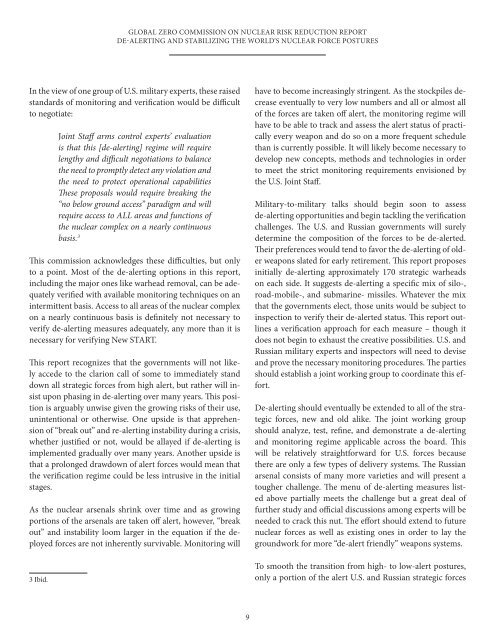global_zero_commission_on_nuclear_risk_reduction_report
global_zero_commission_on_nuclear_risk_reduction_report
global_zero_commission_on_nuclear_risk_reduction_report
You also want an ePaper? Increase the reach of your titles
YUMPU automatically turns print PDFs into web optimized ePapers that Google loves.
GLOBAL ZERO COMMISSION ON NUCLEAR RISK REDUCTION REPORTDE-ALERTING AND STABILIZING THE WORLD’S NUCLEAR FORCE POSTURESIn the view of <strong>on</strong>e group of U.S. military experts, these raisedstandards of m<strong>on</strong>itoring and verificati<strong>on</strong> would be difficultto negotiate:Joint Staff arms c<strong>on</strong>trol experts’ evaluati<strong>on</strong>is that this [de-alerting] regime will requirelengthy and difficult negotiati<strong>on</strong>s to balancethe need to promptly detect any violati<strong>on</strong> andthe need to protect operati<strong>on</strong>al capabilitiesThese proposals would require breaking the“no below ground access” paradigm and willrequire access to ALL areas and functi<strong>on</strong>s ofthe <strong>nuclear</strong> complex <strong>on</strong> a nearly c<strong>on</strong>tinuousbasis. 3This <str<strong>on</strong>g>commissi<strong>on</strong></str<strong>on</strong>g> acknowledges these difficulties, but <strong>on</strong>lyto a point. Most of the de-alerting opti<strong>on</strong>s in this <strong>report</strong>,including the major <strong>on</strong>es like warhead removal, can be adequatelyverified with available m<strong>on</strong>itoring techniques <strong>on</strong> anintermittent basis. Access to all areas of the <strong>nuclear</strong> complex<strong>on</strong> a nearly c<strong>on</strong>tinuous basis is definitely not necessary toverify de-alerting measures adequately, any more than it isnecessary for verifying New START.This <strong>report</strong> recognizes that the governments will not likelyaccede to the clari<strong>on</strong> call of some to immediately standdown all strategic forces from high alert, but rather will insistup<strong>on</strong> phasing in de-alerting over many years. This positi<strong>on</strong>is arguably unwise given the growing <strong>risk</strong>s of their use,unintenti<strong>on</strong>al or otherwise. One upside is that apprehensi<strong>on</strong>of “break out” and re-alerting instability during a crisis,whether justified or not, would be allayed if de-alerting isimplemented gradually over many years. Another upside isthat a prol<strong>on</strong>ged drawdown of alert forces would mean thatthe verificati<strong>on</strong> regime could be less intrusive in the initialstages.As the <strong>nuclear</strong> arsenals shrink over time and as growingporti<strong>on</strong>s of the arsenals are taken off alert, however, “breakout” and instability loom larger in the equati<strong>on</strong> if the deployedforces are not inherently survivable. M<strong>on</strong>itoring will3 Ibid.have to become increasingly stringent. As the stockpiles decreaseeventually to very low numbers and all or almost allof the forces are taken off alert, the m<strong>on</strong>itoring regime willhave to be able to track and assess the alert status of practicallyevery weap<strong>on</strong> and do so <strong>on</strong> a more frequent schedulethan is currently possible. It will likely become necessary todevelop new c<strong>on</strong>cepts, methods and technologies in orderto meet the strict m<strong>on</strong>itoring requirements envisi<strong>on</strong>ed bythe U.S. Joint Staff.Military-to-military talks should begin so<strong>on</strong> to assessde-alerting opportunities and begin tackling the verificati<strong>on</strong>challenges. The U.S. and Russian governments will surelydetermine the compositi<strong>on</strong> of the forces to be de-alerted.Their preferences would tend to favor the de-alerting of olderweap<strong>on</strong>s slated for early retirement. This <strong>report</strong> proposesinitially de-alerting approximately 170 strategic warheads<strong>on</strong> each side. It suggests de-alerting a specific mix of silo-,road-mobile-, and submarine- missiles. Whatever the mixthat the governments elect, those units would be subject toinspecti<strong>on</strong> to verify their de-alerted status. This <strong>report</strong> outlinesa verificati<strong>on</strong> approach for each measure – though itdoes not begin to exhaust the creative possibilities. U.S. andRussian military experts and inspectors will need to deviseand prove the necessary m<strong>on</strong>itoring procedures. The partiesshould establish a joint working group to coordinate this effort.De-alerting should eventually be extended to all of the strategicforces, new and old alike. The joint working groupshould analyze, test, refine, and dem<strong>on</strong>strate a de-alertingand m<strong>on</strong>itoring regime applicable across the board. Thiswill be relatively straightforward for U.S. forces becausethere are <strong>on</strong>ly a few types of delivery systems. The Russianarsenal c<strong>on</strong>sists of many more varieties and will present atougher challenge. The menu of de-alerting measures listedabove partially meets the challenge but a great deal offurther study and official discussi<strong>on</strong>s am<strong>on</strong>g experts will beneeded to crack this nut. The effort should extend to future<strong>nuclear</strong> forces as well as existing <strong>on</strong>es in order to lay thegroundwork for more “de-alert friendly” weap<strong>on</strong>s systems.To smooth the transiti<strong>on</strong> from high- to low-alert postures,<strong>on</strong>ly a porti<strong>on</strong> of the alert U.S. and Russian strategic forces9


